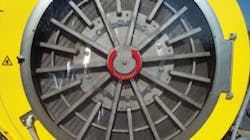Napa River water quality, flood damage, salmon to be addressed by millions in state, local funding under two restoration projects
SAN FRANCISCO, CA, Dec. 12, 2011 -- Nearly $3.3 million in federal, state and local funding is aimed at restoring water quality and riparian and aquatic habitats in the Napa River watershed. As part of two major restoration efforts covering 15 miles of the Napa River, more than 40 landowners have committed to converting nearly 135 acres of farmland to wildlife habitat.
Regional steelhead and Chinook salmon populations have suffered steep declines as a result of high concentrations of fine sediment in the Napa River, which clouds spawning gravel. In-stream erosion has degraded the once complex channel, severely reducing rearing habitat for these species. The river, which runs 55 miles from Mt. St. Helena to the San Pablo Bay, is also prone to seasonal flooding from November to April.
"Despite long-term habitat degradation and falling fish populations, the Napa River represents one of the most important watersheds within the San Francisco Bay-Delta estuary for the recovery of regional steelhead populations," said EPA Regional Administrator for the Pacific Southwest, Jared Blumenfeld. "This $1.5 million EPA grant will help manage erosion, improve spawning gravel, and create habitat for critically endangered salmon."
The pioneering private-public partnership is designed to improve water quality and salmon habitat and address eroding streambanks within this important agricultural area.
The Napa River has cut down so much that it's up to three times deeper than it once was, creating vertical stream banks up to 30 feet high. In some locations the banks have become unstable and subject to catastrophic collapse. The river channel is also much narrower than before, making flows more erosive. To stabilize river banks and create wildlife habitat, vineyard owners in the Rutherford area have committed to converting 20 acres of agriculture land back to river habitat. Landowners are continuing the restoration of the Napa River south of Rutherford between Oakville and Oak Knoll in the Napa Valley and in total, have committed to restoring more than 115 acres.
"Today's announcement is a win for our environment, wildlife, and economy," said Rep. Thompson (CA-01). "We are reducing erosion and sediment runoff, we are improving steelhead and Chinook salmon habitat, and we are strengthening the Napa River which is at the heart of our economy, giving life to agriculture and our thriving wine industry that pumps more than $61 billion into our economy every year. I thank the grape growers and landowners for their partnership and commitment to this restoration process."
The Napa River historically supported a run of 6,000-8,000 steelhead, but by the late 1960s those numbers had declined to an estimated 2,000 adults. Today the steelhead run is estimated to be less than a few hundred adults.
The EPA grant will help restore Napa River water quality by implementing several priority actions of the Napa River Sediment total maximum daily load (TMDL) and habitat enhancement plan. The grant, with nearly $1.8 Million in matching and leveraged funds, will:
• Restore a nearly mile-long section of the Napa River in Rutherford to improve steelhead and Chinook habitat and water quality;
• Complete restoration design along an additional 3.9 miles of the Napa River in Oakville and eradicate 5 acres of invasive non-native Giant Reed and plant native riparian trees;
• Assist ranchers to reduce erosion on 80% of Napa watershed grazing lands in the watershed;
• Implement BMPs to reduce sediment runoff from rural roads and stream crossings throughout the watershed.
• Establish a tracking system to advance water quality improvements through increased accountability.
The primary grant recipient is Napa County, in partnership with the Napa County Resource Conservation District, the California Land Stewardship Institute, U.C. Cooperative Extension and the Rutherford Dust Restoration Team of the Rutherford Dust Society landowner group. The grant builds on more than two decades of local stewardship involving landowners, the County, elected officials and partner agencies.
Napa County Supervisor Diane Dillon says, "We are very grateful to be receiving this grant from EPA and also grateful to all our other project partners in restoring the Napa River, including the voters in Napa County who approved County Measure "A," which has been vital in making all this possible."
The Napa River watershed has many active stakeholders showcasing environmental innovation and leadership, and represents an opportunity to succeed in minimizing polluted runoff, restoring impaired waters, maintaining native fisheries and implementing pollution standards.
"The River Restoration Project is striking a balance between economy and ecology," says local vintner and land manager Davie Pina. "Landowners, the community, and government are investing equitably in the preservation of our environmental and agricultural heritage for the benefit of future generations."
The EPA has been active in the Napa River watershed providing technical and financial assistance since the early 1990s. Since 2007, Napa has received approximately $4.8 million in EPA grants for sediment management.
The grant funding source is $22 million appropriated since 2008 for San Francisco Bay, currently supporting 38 projects, with 53 organizations leveraging and matching more than $42 million.
For more information: http://www.epa.gov/region9/mediacenter/napariver/
###

